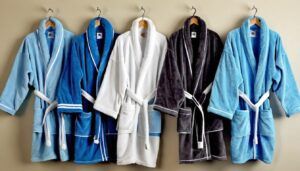Introduction
In the fast-paced world of hospitality, where guests’ comfort and hygiene are of utmost importance, bathrobe laundering becomes an essential part of their experience. These cozy outfits, which are associated with elegance and leisure, are essential to giving visitors a sense of indulgence and ease while they are here. The cleanliness and freshness of guests’ bathrobes become crucial when they relax and revive in the comfort of their rooms. Following industry standards and paying close attention to detail is necessary to guarantee that these robes are cleaned to perfection. The necessity of immaculate bathrobes goes beyond simple aesthetics—from legal obligations to visitor expectations—and illustrates the hospitality properties’ dedication to providing extraordinary experiences.
Factors Influencing Laundering Frequency
Several factors impact the frequency of bathrobe laundering in hospitality properties, and each of these elements is crucial in establishing the ideal laundering schedule. First and foremost, guest occupancy rates are a major factor, as increased occupancy frequently calls for more regular laundering in order to uphold cleanliness requirements. Seasonal variations also affect robe usage and soiling rates since they affect differences in guest counts and weather. The amount of times robes need to be laundered is also influenced by usage patterns, such as in-room meals and spa services. Robes get soiled more frequently in places with high activity. In addition, the kind and caliber of fabric used to make the robes is quite important; some fabrics need to be laundered more frequently in order to maintain their beauty and softness.

Industry Standards for Bathrobe Laundering
In the hospitality industry, industry standards for bathrobe laundering are set to guarantee uniformity in cleanliness and visitor pleasure throughout all locations. These standards cover a variety of directives and procedures intended to preserve standards of quality and hygiene. First, minimum laundering frequency and recommended techniques to stop the spread of infections and keep a clean environment are outlined in regulatory criteria set forth by health and safety authorities. Furthermore, associations and organizations within the sector could offer certifications and suggestions for laundry procedures, such using particular detergents or temperature settings. To guarantee that robes are properly cleaned and rejuvenated in between visitor stays, properties frequently use standardized cleaning procedures, which include pre-treatment for stains, appropriate washing techniques, and thorough drying methods.
Benefits of Regular Laundering
Bathrobe cleaning on a regular basis provides a host of advantages for hospitality establishments that boost visitor happiness and operational effectiveness. First off, regular washing keeps everything as clean as possible by eliminating perspiration, grime, and bacteria that build up from visitors’ use and preserving the environment’s hygiene. Additionally, clean, freshly laundered robes exude comfort and luxury, which improves the whole visitor experience and raises satisfaction levels. Regular laundry reduces the need for premature replacement of bathrobes and minimizes expenditures for property owners by limiting the accumulation of stains and odors. Additionally, spotless robes enhance the perception of the business, making an excellent first impression on visitors and promoting return business and favorable evaluations.
Signs of Overdue Laundering
Cleaning and client satisfaction in hospitality buildings depend on the ability to spot the telltale symptoms of past-due laundry in bathrobes. A notable clue is the persistence of smells, which suggests that the robes have gradually absorbed perspiration, body oils, and other impurities. To make matters worse, longer laundering intervals accentuate apparent stains and discolorations, which take away from the robes’ neat appearance. Detergent residues and accumulated filth can cause the fabric to lose its softness and comfort, which can lead to a harsh or stiff feel from overlaundering. Reduced satisfaction and possibly unfavorable evaluations could result from guests seeing a drop in freshness and cleanliness.

Laundering Techniques and Best Practices
The quality and cleanliness of bathrobes in lodging establishments are greatly dependent on laundry methods and best practices. First things first: choosing the right detergent is crucial. To maintain the fabric’s softness and color, gentle, hypoallergenic choices are frequently recommended. Robe organization by color and fabric type promotes the best possible washing outcomes and lessens the chance of color bleeding. The best way to remove dirt and stains without causing too much shrinking or harm to sensitive fibers is to use cold or lukewarm water temps. Delicate or hand wash cycles are examples of gentle washing cycles that assist reduce excessive agitation and friction, which can deteriorate cloth. Aside from that, not filling the washer to capacity ensures that water and detergent are distributed evenly and that every robe is thoroughly cleaned.
Addressing Environmental Concerns
In order to be sustainable, lodging establishments must take bathrobe laundering into consideration. Using environmentally friendly detergents that clean the robes well and have the least negative influence on aquatic ecosystems and water systems is one strategy. The use of water and energy-efficient washing machines and drying equipment, for example, lowers the amount of resources used and the carbon emissions produced by laundry operations. Water and energy can be saved by encouraging visitors to reuse their bathrobes during their visit rather than asking for fresh ones every day. The property’s carbon footprint is further decreased by using renewable energy sources for laundering operations, such as solar or wind power. Additionally, bathrobe lifespans can be increased and overall resource consumption can be decreased by investigating novel fabric treatments that call for less frequent laundering.
Case Studies
Analyzing case studies yields insightful information about efficient bathrobe laundering practices used by lodging establishments. For example, a five-star resort in a tropical location that laundered its bathrobes every day saw a continuous increase in client satisfaction and favorable evaluations complimenting the robes’ cleanliness and freshness. Comparably, a boutique hotel in an urban location reduced resource consumption by 20% while maintaining cleanliness standards by implementing eco-friendly detergents and water-saving techniques in its laundry process. A major hotel chain is the subject of another case study. By investing in automated laundry equipment, the business was able to streamline operations, cut labor expenses, and guarantee that robes were always clean and ready for customers.
Challenges in Maintaining Bathrobe Hygiene
Bathrobe hygiene presents a number of issues that, in order to be effectively addressed, require careful study and proactive steps in hospitality businesses. First of all, a steady stream of soiled robes might be produced by high guest turnover rates, necessitating effective laundering procedures to guarantee stock for incoming visitors. Furthermore, varied usage patterns—for example, people sitting by the pool or utilizing robes for spa treatments—introduce different kinds of stains and pollutants that could be harder to remove. Another problem with bathrobe fabrics is their delicate nature, which can eventually deteriorate or be damaged by using harsh detergents or incorrect washing methods. Furthermore, if robes are not properly dried between uses, environmental elements like temperature and humidity can promote the growth of microorganisms and create offensive smells.


Wonderful
Nice
Nice job
Looks great